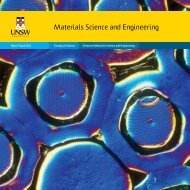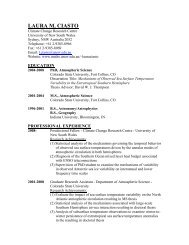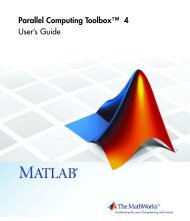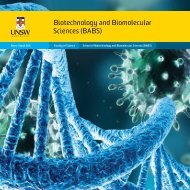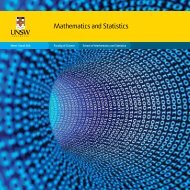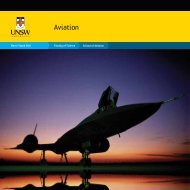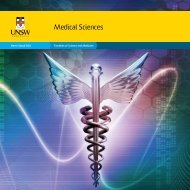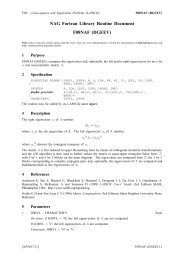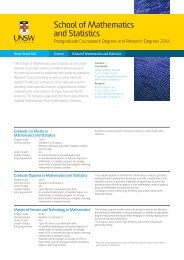2011 Postgraduate Research Competition - UNSW Science - The ...
2011 Postgraduate Research Competition - UNSW Science - The ...
2011 Postgraduate Research Competition - UNSW Science - The ...
You also want an ePaper? Increase the reach of your titles
YUMPU automatically turns print PDFs into web optimized ePapers that Google loves.
Page |18<br />
Using hole transitions in highly charged ions as a<br />
test for varying fundamental constants<br />
Andrew Ong, Victor Flambaum and Julian Berengut<br />
School of Physics<br />
Abstract<br />
<strong>The</strong> ongoing search for a cosmological variation of fundamental constants has prompted<br />
independent laboratory corroboration of what might be one of the most counter-intuitive<br />
theories yet - that the fundamental constants that govern our universe actually vary, itself an<br />
important and necessary for grand unifying theories of nature to be formulated.<br />
Cosmological searches have focused on the spatial variation of these constants, therefore if<br />
such is true then since our solar system is moving through a region of changing constants, in<br />
time we should be able to detect this variation using clocks in laboratories as well. Atomic<br />
clocks are the most precise clocks available, and we have discovered that using hole<br />
transitions in highly charged ions as a basis for atomic clocks, combined with specific level<br />
crossings, a factor of 13 improvement in sensitivity can be yielded over the best current<br />
experimental results. We believe that this level of precision will most likely be sufficient in<br />
detecting a spatial variation of fundamental constants in a laboratory conclusively.<br />
Abstract<br />
Adaptation improves neural coding efficiency<br />
despite increasing correlations in variability<br />
Mehdi Adibi and Ehsan Arabzadeh<br />
School of Psychology<br />
Prolonged exposure of cortical neurons to sensory stimuli results in a change in their response<br />
function. This phenomenon, known as sensory adaptation, is a common feature across<br />
sensory modalities. Here, we characterise adaptation in rat whisker system. This is an ideal<br />
model system because of its functional efficiency and its well-studied anatomical<br />
organisation. Every whisker is represented by a cluster of neurons in S1, called a barrel. Barrels<br />
preserve the arrangement of whiskers on the snout. Using an electrode array, we<br />
extracellularly recorded the activity of barrel cortex neurons in anaesthetised rats and<br />
characterised the response of neurons in 3 states of adaptation. <strong>The</strong> stimuli comprised of<br />
vibrations ranging 0-33µm while the adapters had magnitudes of 0, 6µm or 12µm. <strong>The</strong><br />
neuronal responses, as a function of test stimulus amplitude, were well-fit by a sigmoid curve.<br />
Simultaneous recordings from multiple neurons (5-25 units) in one session allowed us to<br />
quantify the trial-by-trial correlations across neurons (in the form of signal- and noisecorrelations).<br />
<strong>The</strong> noise correlation was in the direction of the signal correlation which led to a<br />
decreased discriminability of the population by as much as 14% compared to an<br />
independent population. <strong>The</strong> adapters produced a systematic lateral shift in the population<br />
response function. <strong>The</strong> magnitude of the rightward shift was proportional to the amplitude of<br />
the adapter. Receiver operating characteristics (ROC) and information theoretic analyses<br />
revealed that adaptation enhances the discrimination performances most prominently at<br />
amplitudes greater than the adapter.<br />
cutting-edge discovery science|



